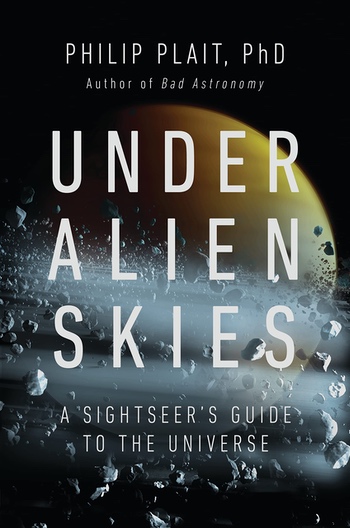 |
Review: Under Alien Skies
by Jeff Foust
Monday, June 26, 2023
Under Alien Skies: A Sightseer’s Guide to the Universe
By Phil Plait
W. W. Norton & Company, 2023
hardcover, 336 pp., illus.
ISBN 978-0-393-86730-5
US$30.00
Astronomers provided a bit of disappointing news last week about an exoplanet. Observations of TRAPPIST-1 c, one of seven planets known to orbit a red dwarf star, led astronomers to conclude the Earth-sized planet either has a tenuous atmosphere of carbon dioxide or no atmosphere at all. Before the James Webb Space Telescope observations, astronomers suspected the planet, while unlikely to be habitable, might have a dense Venus-like atmosphere. That could mean more distant planets could also lack atmospheres, if they formed in the same environment.
The TRAPPIST-1 system is one of the destinations in Under Alien Skies by Phil Plait, an astronomer and science communicator widely known as the “Bad Astronomer.” Plait takes the reader on a fascinating tour of the solar system and beyond, using destinations from the Moon to black holes to enlighten readers about aspects of astronomy and planetary science.
| Plait writes in a fun, accessible style (“We humans are gloppy bags of meat, and we need water to live,” he writes on the importance of finding water ice on the Moon) but there is plenty to learn. |
The use of “tour” above is more than a figure of speech: Plait structures the book as through the reader was visiting these worlds, watching a solar eclipse from the Moon or looking up at Saturn’s rings from its atmosphere (hence the “under alien skies” of its title.) That allows him to explore what we know about a variety of destinations in the solar system and galaxy. The chapter about the Moon, for example, discusses topics from lunar phases to the potential for ice at the lunar poles and the using the lunar farside for radio astronomy, shielded from the Earth’s radio chatter.
Plait writes in a fun, accessible style (“We humans are gloppy bags of meat, and we need water to live,” he writes on the importance of finding water ice on the Moon) but there is plenty to learn even for those familiar with much of the science in the book, thanks to his attention to detail. For example, on those TRAPPIST-1 worlds, 40 light-years from Earth, the positions of stars will have shifted enough to alter familiar constellations like Orion, “distorting the constellation severely while keeping it more or less recognizable.”
Some of the destinations mentioned in the book may be visited relatively soon by people: within a decade humans should be on the Moon, perhaps taking in familiar eclipses from unfamiliar vantage points. Humans may be on Mars in a few decades, and possibly on asteroids in similar time frames. But Saturn and Pluto, two other worlds in our solar system mentioned in the book, are likely beyond the reach of any readers of the book currently alive, and TRAPPIST-1 and beyond may always be out of reach. But the descriptions he provides of floating in Saturn’s atmosphere in a balloon, looking up at the rings, is fascinating enough to make you want to start saving up for a trip, just in case.
Note: we are using a new commenting system, which may require you to create a new account.
No comments:
Post a Comment